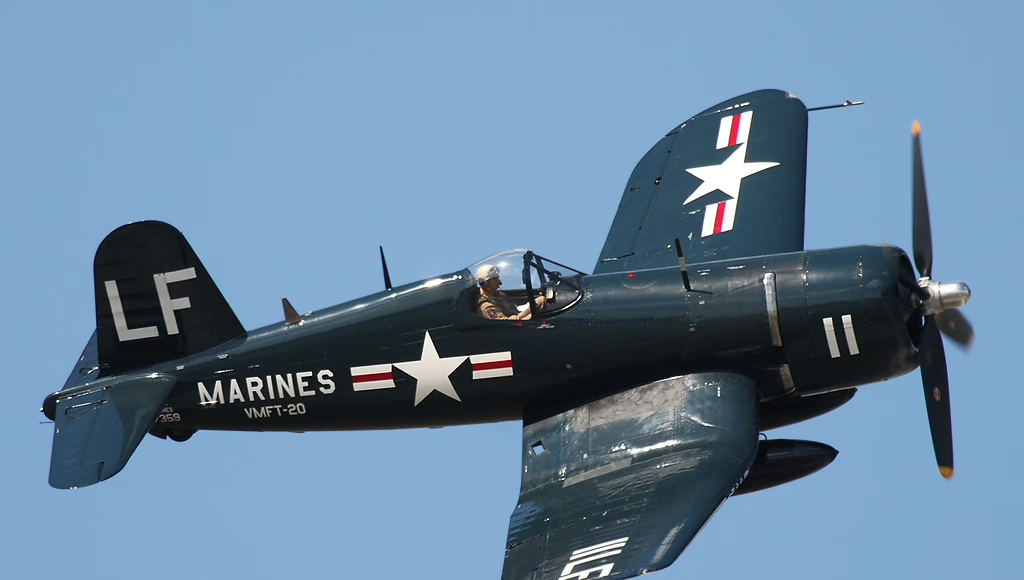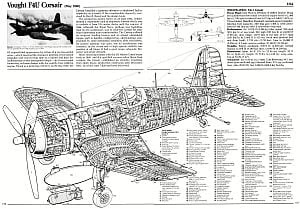Chance Vought F4U Corsair History
Nicknamed the Whistling Death or the Bent Wing bird. Production of two prototypes were approved by Chance Vought designated the V-166As. This model implemented the Pratt & Whitney R-1830 twin Wasp engine. The other design was the V-166B Pratt & Whitney R-2800 twin Wasp Radial engine the most powerful at the time.
Originated with the Vought-Sikorsky Division of United Aircraft Corporation, the Vought V-166B prototype of the Chance Vought F4U Corsair, designated XF4U-1, flew for the first time on 29 May 1940, becoming a few months later the first US warplane to fly faster than 400 mph (644 km/hr). This was the prelude to an 11-year production life, during which twelve thousand five hundred and seventy-one of these fighters were built, and a service career that lasted until the mid-1960s. Acknowledged universally to be the most outstanding carrier-based fighter to be deployed operationally during the war, the Chance Vought F4U Corsair Is and IIs in service with the Royal navy’s Fleet Air Arm were the first to demonstrate the outstanding potential of this design.
The initial US Navy contract was for five hundred and eighty-four F4U-1s, delivery of which began in September 1942. Most of these went to Marine Corps or land-based Navy squadrons, due to early difficulties in operating the Chance Vought F4U Corsair from aircraft carriers, and the first operational missions were flown by Squadron VMF-124 of the USMC in February 1943. The Corsair’s gull-wing configuration was devised to avoid the excessively long undercarriage legs that would otherwise have been necessary to provide clearance for the large-diameter propeller; but the far-fat cockpit position gave the pilot a poor view forward when landing. Hence from the six hundred and eighty-ninth F4U-1 onward, a new, raised cockpit hood was introduced on the Corsairs being built by Vought and Brewster Goodyear factories. The Vought F4U-1C was armed with four 20 mm wing cannon instead of the former six machine-guns, while the F4U-1D (Goodyear FG-1D) had an R-2800-8W water injection engine and provision for eight underwing rocket projectiles or two 1,000 lb (454 kg bombs).
The British Corsair Mks II to IV had each wingtip clipped by 8 in (20.3 cm) to facilitate stowage aboard Royal Navy carriers, and precede their US counterparts into shipboard service, carrying out their first operational action in April 1944. First Operational use of Fleet Air Arm the Chance Vought F4U Corsair IIs was made by No. 1834 Squadron, flying off HMS Victorious and providing a component of the escorting fighters when Fairey Barracudas made their memorable attack on the German battleship Tirpitz in Kaafjord, Norway, on 3 April 1944.
When the last F4U-7 came off the lines at Dallas, Texas, in December 1952, production had been continuous for over 10 years, a period in which a total of 12,571 examples of this outstanding fighter had been built by Vought, Brewster and Goodyear.
The Pilots
The most flamboyant, outspoken and highest-scoring Marine Corps fighter pilot of WWII was Colonel “Pappy” Boyington, VMF-214 the “Black Sheep”. As Squadron Leader. He operated out of Vella Lavella in the South Pacific. Pappy’s total was 28 enemy aircraft downed. Upon his release from 20 months as a prisoner of the Japanese he was ordered to Washington to receive the nations highest award the Medal of Honor from President Harry S. Truman.
Lt. Robert Hanson ( The Terror of Rabaul) VMF-215 flying out of Vella Lavella Bouganville for a short period, VMF-215 was moved to a new base at Torokina closer to Raboul. Lt. Robert Hanson shot down 25 enemy aircraft in just 3 months and 20 in 17 days in just six missions. This was an accomplishment that was never equalled by any other WWII Allied Pilot. VMF-215 produced 10 aces during the campaign against Rabaul and shot down 137 enemy aircraft in just 18 weeks.
Ensign Ira Kempford (“Blackburns Irregulars”) VF-17 they lived up to their name They disrupted many country social events buzzing race tracks, official ceremonies, farmers, local citizens and were known to run vehicles off the road while inverted. The Navy was happy to transfer them to the South Pacific. They compiled some amazing statistics, 8,557 combat hours, 156 enemy aircraft shot down, five ships sunk and produced more aces than any other Navy unit, and all this was accomplished in just 76 days. Kempford became the fifth-highest scoring Navy ace of WWII with an official score of 17 Japanese aircraft shot down.
Lt. Alvin J.Jensen VMF-214 after getting lost and caught in a very severe storm he came out of the storm in a spin and inverted after he managed to regain control, he realized that directly below was a Japanese airfield. He immediately attacked the airfield and in doing so destroyed 24 aircraft, four Vals, eight Zekes and twelve Betty’s before returning to Vella Lavella. This was described as the greatest single-handed feat of the Pacific War. For this, he was awarded the Navy Cross.
Chance Vought F4U Corsair Specifications
| Aircraft Type: |
| fighter |
| Dimensions: |
| wingspan: 40 ft, 11 in |
| length: 33 ft, 8 in |
| height: 14 ft, 9 in |
| Weights: |
| empty: 9,900 lb |
| gross: 14,079 lb |
| Power plant: |
| 1 × 2,850 hp Pratt & Whitney Double Wasp radial engine |
| Performance: |
| maximum speed: 1 mph |
| ceiling: 44,000 ft |
| maximum range: 1,000 mi |
| Armament: |
| 6 × 0.50 in calibre machine guns |
| 4 × 20 mm calibre cannons |
| 2,000 lb of bombs |
| Operational Use: |
| 1942–1952 |





